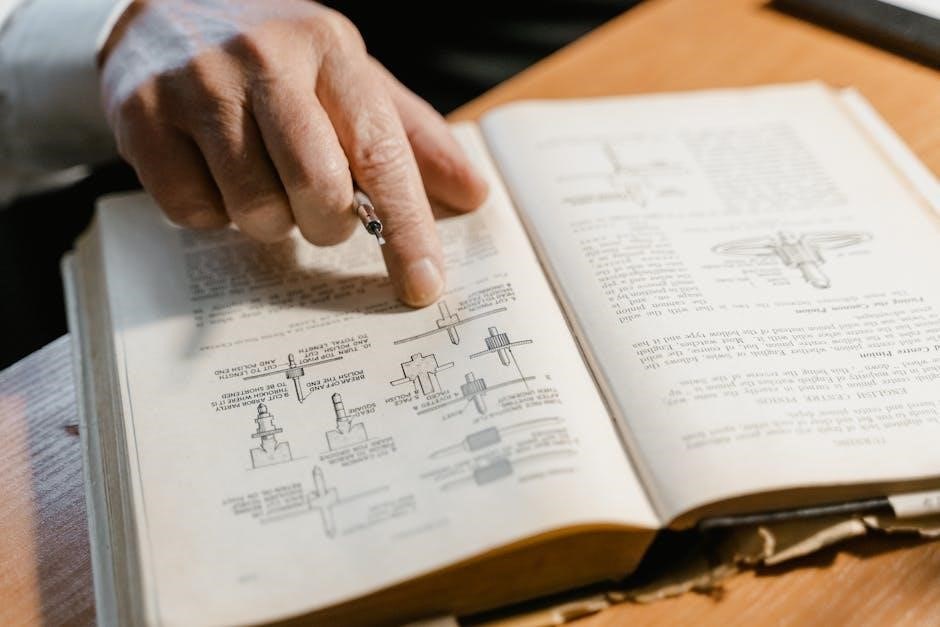The Legend of Zelda NES instruction manual is essential for understanding gameplay mechanics and ensuring proper handling․ It provides vital information for both new and experienced players‚ detailing controls‚ items‚ and objectives․
1․1․ Background of The Legend of Zelda
The Legend of Zelda‚ released in 1986 for the NES‚ marked a groundbreaking moment in gaming history․ Created by the visionary Shigeru Miyamoto‚ the game introduced players to the vast kingdom of Hyrule‚ where the brave hero Link embarks on a quest to save Princess Zelda and the land from the clutches of Ganon․ The game’s concept was inspired by Miyamoto’s childhood experiences‚ such as exploring caves and discovering hidden secrets․ The Legend of Zelda was one of the first games to feature an open-world design‚ allowing players to explore freely․ It also introduced the iconic Triforce‚ a symbol of power‚ wisdom‚ and courage‚ which became central to the series’ lore․ The game’s success led to numerous sequels and solidified its place as a pioneer in action-adventure games‚ influencing countless titles that followed․ Its Legacy continues to be celebrated by gamers worldwide․

1․2․ Importance of the Instruction Manual
The instruction manual for The Legend of Zelda is a crucial resource for players‚ providing essential guidance for navigating the game’s world and mechanics․ It outlines the game’s story‚ controls‚ and objectives‚ ensuring players understand the basics of gameplay․ The manual also details the use of items‚ weapons‚ and the inventory system‚ which are vital for progression․ Additionally‚ it includes safety precautions and handling instructions for the NES cartridge‚ emphasizing proper care to maintain functionality․ The manual serves as a reference point for both new and experienced players‚ offering insights into the game’s design and helping to enhance the overall gaming experience․ Its clear and concise instructions make it an indispensable companion for anyone embarking on the adventure in Hyrule․ The manual’s importance extends beyond gameplay‚ as it has become a collector’s item for fans of the series․

Game Story and Setting
The Legend of Zelda unfolds in the mystical land of Hyrule‚ where the Triforce holds ancient power․ Link embarks on a quest to rescue Princess Zelda and restore peace․
2․1․ Overview of Hyrule and the Triforce
Hyrule is a sacred realm governed by the Triforce‚ a divine artifact representing power‚ wisdom‚ and courage․ The land is divided into an overworld and an underworld‚ each filled with hidden temples and secrets․ The Triforce is central to the kingdom’s prosperity and is often sought by evil forces․ Link’s journey to unite its fragments is crucial to restoring balance․ The manual highlights the importance of understanding Hyrule’s layout and the Triforce’s role in the quest․ This knowledge aids players in navigating the overworld‚ uncovering hidden paths‚ and overcoming challenges․ The Triforce’s power is a recurring theme‚ emphasizing its significance in both the game’s lore and gameplay mechanics․
2․2․ Role of Link and Zelda
Link‚ the brave hero‚ is tasked with rescuing Princess Zelda from the clutches of evil forces and restoring peace to Hyrule․ Equipped with courage and wisdom‚ Link embarks on a perilous journey to unite the fragments of the Triforce․ Zelda‚ the princess‚ plays a pivotal role as the holder of wisdom‚ often guiding Link through her imprisonment․ Together‚ they form the heart of Hyrule’s destiny․ The manual emphasizes Link’s ability to name his character‚ allowing players to personalize their adventure․ With a maximum of three save slots‚ players must strategically manage their progress․ The dynamic between Link and Zelda underscores the importance of collaboration and heroism‚ central to the game’s narrative and gameplay․ This iconic duo’s roles are intricately woven into the fabric of Hyrule’s legend․
2․3․ Main Quest Objective
The primary objective of The Legend of Zelda is to retrieve the eight fragments of the Triforce of Wisdom‚ which are hidden in various dungeons across the overworld and underworld․ Link must explore vast landscapes‚ solve puzzles‚ and battle enemies to uncover these fragments․ Once all fragments are collected‚ the Triforce of Wisdom is restored‚ allowing Link to enter Ganon’s lair and confront the dark lord․ The ultimate goal is to defeat Ganon‚ rescue Princess Zelda‚ and restore peace to the kingdom of Hyrule․ The instruction manual emphasizes the importance of carefully navigating the overworld‚ utilizing items like the boomerang and bombs‚ and deciphering clues hidden within the game’s environments․ Success requires strategic thinking‚ courage‚ and mastery of Link’s abilities․ The manual also highlights the necessity of avoiding traps and enemies while efficiently managing resources․ This epic quest forms the backbone of the game’s timeless adventure․

Game Controls
The game controls are intuitive‚ allowing Link to move in eight directions using the D-pad․ Buttons A and B handle item usage and sword attacks‚ while Start and Select manage the menu․

3․1; Basic Movement Controls
The game utilizes the NES controller’s D-pad for movement‚ allowing Link to navigate in eight directions: up‚ down‚ left‚ right‚ and the four diagonals․ This setup ensures precise control over Link’s movements in the overworld and dungeons․ The Start button pauses the game and opens the menu‚ while the Select button switches between items in Link’s inventory․ The A button is used to attack with the sword‚ and the B button equips and uses items such as bombs or arrows․ Proper use of these controls is essential for exploring Hyrule‚ battling enemies‚ and solving puzzles․ The instruction manual emphasizes mastering these controls to optimize gameplay and avoid unnecessary mistakes․ By familiarizing yourself with the layout‚ you can seamlessly transition between exploration and combat‚ enhancing your overall experience in the game․
3․2․ Using Items and Weapons
In The Legend of Zelda‚ items and weapons are crucial for progression․ The B button is used to equip and use items like bombs‚ boomerangs‚ and arrows․ When equipped‚ the A button triggers their use․ For example‚ bombs can destroy rocks and defeat enemies‚ while the boomerang can stun foes and retrieve items․ The bow requires arrows to fire‚ which can be collected or purchased․ Items are selected using the Select button‚ allowing quick access during exploration or combat․ Proper use of these tools is vital for overcoming obstacles and defeating enemies․ The instruction manual details each item’s function and how to integrate them into your strategy․ Mastering item usage enhances gameplay efficiency and ensures you can tackle challenges effectively․ This system emphasizes resource management‚ as items like bombs and arrows are limited and must be used wisely․
3․3․ Inventory Management
Managing your inventory is crucial in The Legend of Zelda․ Link can carry a limited number of items‚ so it’s essential to use them wisely․ The Select button allows you to switch between items‚ while the A or B button activates them․ For example‚ bombs can clear paths‚ and the boomerang can retrieve distant items․ The manual emphasizes organizing your inventory to ensure you have the right tools for each situation․ As you progress‚ you’ll collect more items‚ but limited slots mean you must prioritize․ Effective inventory management is key to solving puzzles and overcoming challenges․ The instruction manual provides guidance on how to handle your items efficiently‚ ensuring you’re always prepared for what lies ahead․ Properly managing your inventory enhances your ability to explore and succeed in the game․ This system encourages strategic thinking and resourcefulness․
3․4․ Navigating the Overworld and Underworld
Navigation in The Legend of Zelda requires careful exploration of both the Overworld and Underworld․ The Overworld is a vast landscape filled with hidden secrets‚ while the Underworld consists of intricate dungeons․ Use the map and compass to track your progress and locate essential items․ The manual advises using landmarks and environmental clues to guide your journey․ Transitioning between the Overworld and Underworld often involves discovering hidden entrances‚ such as caves or dungeon doors․ Proper navigation is key to uncovering the Triforce fragments and progressing through the game․ The instruction booklet provides tips for efficient exploration‚ ensuring you don’t miss critical paths or items․ By mastering navigation‚ you’ll effectively traverse Hyrule and overcome its challenges․ This skill is vital for completing the main quest and saving the kingdom․

Gameplay Mechanics
The Legend of Zelda features core mechanics like health management‚ currency collection‚ and combat․ Players must master these elements to progress through the game effectively and defeat enemies․
4․1․ Health and Heart System
The Legend of Zelda features a health system based on heart containers․ Link begins with three full hearts‚ each representing a segment of his health․ As he takes damage from enemies or hazards‚ these segments decrease․ Players can collect additional heart containers hidden throughout Hyrule to increase Link’s maximum health․ These containers are often found in forests‚ caves‚ or by defeating specific enemies․ Additionally‚ heart refills can be obtained by collecting Heart items‚ which restore lost health segments․ Managing health is crucial‚ as losing all heart segments results in a game over and loss of progress․ This system encourages strategic gameplay and careful exploration to ensure Link remains viable throughout his quest․ The heart system is a core mechanic that enhances the game’s challenge and rewards skillful play․
4․2․ Currency and Rupees
In The Legend of Zelda‚ Rupees serve as the primary currency‚ enabling players to purchase essential items and tools․ Rupees can be collected by defeating enemies‚ breaking pots‚ or uncovering hidden caches throughout Hyrule․ The value of Rupees varies by color‚ with green Rupees worth one unit‚ while others‚ such as blue or red‚ hold higher values․ Accumulating Rupees allows Link to acquire vital items like bombs‚ arrows‚ or keys from shops․ Managing Rupees wisely is crucial‚ as they are limited and necessary for progressing through the game․ The Rupee system adds a layer of strategy‚ encouraging players to explore thoroughly and defeat enemies to amass wealth․ This mechanic enhances the game’s depth and rewards resourceful gameplay․
4․3․ Combat and Enemy Interactions
Combat in The Legend of Zelda is a core aspect of gameplay‚ requiring strategic use of weapons and defensive tactics․ Link’s primary weapon‚ the sword‚ allows him to attack enemies at close range‚ while the shield can block incoming projectiles․ Players must observe enemy patterns to time attacks effectively․ Projectile weapons like the boomerang or arrows provide ranged combat options‚ useful for defeating enemies from a distance․ Certain enemies‚ such as Moblins or Stalfos‚ require specific strategies to overcome․ Defeating enemies often rewards Rupees‚ adding an incentive to engage in combat․ As players progress‚ tougher foes emerge‚ demanding improved skills and equipment․ Mastering combat is essential for survival‚ especially in the later stages of the game․ The variety of enemies and combat mechanics ensures dynamic and challenging interactions throughout Link’s adventure․
4․4․ Solving Puzzles and Progressing Through Dungeons
Solving puzzles and navigating dungeons are central to The Legend of Zelda․ Players must use items like bombs to break walls or the boomerang to activate switches․ Dungeon layouts often require careful exploration‚ with hidden doors and secret passages revealed by bombing or burning bushes․ The map and compass are essential tools‚ helping players track their progress and identify unexplored areas․ Puzzles frequently involve pushing blocks to uncover paths or using keys to unlock doors․ Defeating the dungeon’s boss typically requires specific strategies and items․ Conservation of resources‚ such as bombs and arrows‚ is crucial for overcoming challenges․ By thoroughly exploring and utilizing items wisely‚ players can progress through dungeons and advance in the game․ Each dungeon presents unique puzzles‚ ensuring a fresh and engaging experience as Link journeys to rescue Zelda․

Items and Equipment
Essential items like the sword‚ shield‚ and boomerang aid Link in exploration and combat․ Bombs reveal hidden passages‚ while the bow and arrows enable ranged attacks․ Upgrades enhance abilities‚ ensuring progression․
5․1․ Essential Items in The Legend of Zelda
The Legend of Zelda features a variety of essential items that are crucial for progressing through the game․ The sword is Link’s primary weapon‚ while the shield provides defense against enemy attacks․ The boomerang is versatile‚ allowing Link to stun enemies and retrieve items from a distance․ Bombs can destroy obstacles and reveal hidden passages‚ making them indispensable for exploration․ The bow and arrows enable ranged attacks‚ while the wand and magical rod offer offensive capabilities․ Each item serves a unique purpose‚ and mastering their use is key to overcoming challenges․ The instruction manual highlights these items‚ emphasizing their importance in aiding Link on his quest․ By equipping these tools‚ players can effectively navigate the overworld and dungeons‚ ensuring progress toward the game’s ultimate goal․
5․2․ Upgrades and Their Effects on Gameplay
Upgrades in The Legend of Zelda significantly enhance Link’s abilities‚ offering improved offensive and defensive capabilities․ The wooden sword can be upgraded to the magical sword‚ increasing attack power․ The shield evolves from the blue to the magical shield‚ reducing damage taken․ Bombs can be upgraded to a larger capacity‚ allowing more explosions for clearing paths․ The boomerang is upgraded to the magical boomerang‚ which can be used multiple times․ Arrows are enhanced to silver arrows‚ becoming the only weapon capable of defeating Ganon․ The magical rod transforms into a powerful weapon‚ firing energy beams․ These upgrades are essential for overcoming tougher enemies and progressing through the game․ The instruction manual details each upgrade‚ ensuring players understand how to utilize them effectively․ Upgrades are scattered throughout the game‚ rewarding exploration and strategic play․ They are crucial for balancing gameplay and ensuring Link’s success in his quest․
5․3․ Using Maps and Compass for Navigation
The Legend of Zelda instruction manual emphasizes the importance of using maps and a compass for effective navigation․ These tools are crucial for exploring both the overworld and the underworld‚ helping players identify key locations‚ hidden passages‚ and secret areas․ The map provides a visual representation of the game world‚ marking important sites like dungeons‚ heart containers‚ and item locations․ The compass‚ on the other hand‚ pinpoints the player’s current position and highlights nearby points of interest․ By referencing these tools frequently‚ players can track their progress‚ avoid getting lost‚ and uncover hidden secrets․ The manual also notes that the compass becomes even more vital in the underworld‚ where the layout is more complex․ Without these aids‚ navigating the vast and intricate world of Hyrule would be significantly more challenging․

Dungeons and the Underworld
The Legend of Zelda features intricate dungeons and an expansive underworld‚ filled with puzzles‚ enemies‚ and hidden treasures․ Navigating these areas requires careful exploration and strategic use of items․

6․1․ Structure and Layout of Dungeons
The dungeons in The Legend of Zelda are intricately designed‚ featuring a series of interconnected rooms filled with enemies‚ puzzles‚ and hidden treasures․ Each dungeon‚ or “labyrinth‚” has a unique layout‚ requiring players to use keys to unlock doors and progress․ Heart containers and essential items like bombs and the boomerang are often hidden‚ encouraging thorough exploration․ The manual emphasizes the importance of mapping these areas to avoid getting lost․ Players must strategically use items to overcome obstacles and defeat bosses․ The structure of each dungeon is carefully balanced to challenge players while guiding them toward the ultimate goal of retrieving the Triforce fragments․ By studying the provided maps and strategies‚ players can master the underworld and unlock its secrets․
The Legend of Zelda is renowned for its hidden secrets and easter eggs‚ which enhance gameplay and encourage exploration․ Players can discover secret rooms by bombing specific walls or burning bushes‚ often revealing heart containers‚ rupees‚ or other items․ The manual hints at these hidden areas‚ advising players to thoroughly examine their surroundings․ One notable easter egg is the “Minus World‚” a glitch accessible by manipulating the game’s save menu‚ offering a unique‚ challenging experience․ Additionally‚ the game contains references to other Nintendo titles‚ adding depth for fans․ These secrets not only extend playability but also showcase the game’s intricate design and attention to detail․ Players are rewarded for curiosity and persistence‚ making the game a timeless classic․ The manual guides players in uncovering these hidden gems‚ enriching their adventure․ Completing each dungeon in The Legend of Zelda requires strategic planning and careful exploration․ Use the map and compass to track your progress and identify unexplored areas․ Key items like the compass‚ bombs‚ and boomerang are essential for overcoming obstacles․ Always conserve heart containers and health-restoring items for boss battles․ Explore thoroughly‚ as hidden doors and secret rooms often contain crucial tools or upgrades․ Utilize bombs to reveal hidden passages and defeat sturdy enemies․ Save your progress frequently‚ especially before challenging sections or boss fights․ Pay attention to environmental clues‚ such as cracked walls or burnable bushes‚ which may hide important items․ Managing your inventory wisely ensures you have the right tools for each challenge․ By following these tips‚ players can efficiently navigate and conquer each dungeon‚ progressing smoothly through the game․ The instruction manual provides additional insights to aid in this process․ The manual offers troubleshooting guides for common issues‚ ensuring smooth gameplay․ Tips include managing inventory‚ conserving health‚ and using items effectively․ This section enhances player experience and success․ The Legend of Zelda NES manual addresses common issues players may encounter․ Poor game cartridge connections can cause glitches; cleaning the connector with a soft cloth often resolves this․ If the game freezes‚ restarting the console may be necessary․ Corrupted save data can sometimes occur‚ but using the “Continue” option on the title screen helps recover progress․ For physical copies‚ ensuring the cartridge is properly inserted and the system is turned off before removing it prevents data loss․ The manual also advises against extreme temperatures and improper handling to maintain game quality․ These solutions ensure a smooth gaming experience‚ allowing players to focus on exploring Hyrule and conquering challenges․ To excel in The Legend of Zelda‚ start by thoroughly exploring the overworld and dungeons to uncover hidden secrets and essential items․ Prioritize gathering heart containers to increase Link’s health‚ as this enhances survivability in challenging areas․ Manage your inventory wisely‚ ensuring you have ample arrows‚ bombs‚ and potions for emergencies․ Use the map and compass to navigate effectively‚ marking important locations like dungeon entrances and hidden caves․ When encountering enemies‚ adopt a strategic approach—attack from a distance when possible and conserve health by avoiding unnecessary battles․ Experiment with item combinations to solve puzzles and defeat tougher foes․ Finally‚ save your progress regularly to avoid losing significant advancements․ By mastering these strategies‚ players can overcome the trials of Hyrule and ultimately defeat Ganon․6․2․ Hidden Secrets and Easter Eggs
6․3․ Tips for Completing Each Dungeon

Troubleshooting and Tips
7․1․ Common Issues and Solutions
7․2․ General Gameplay Tips for Success